Unit4 Then and now教案(4个课时)
文档属性
| 名称 | Unit4 Then and now教案(4个课时) | 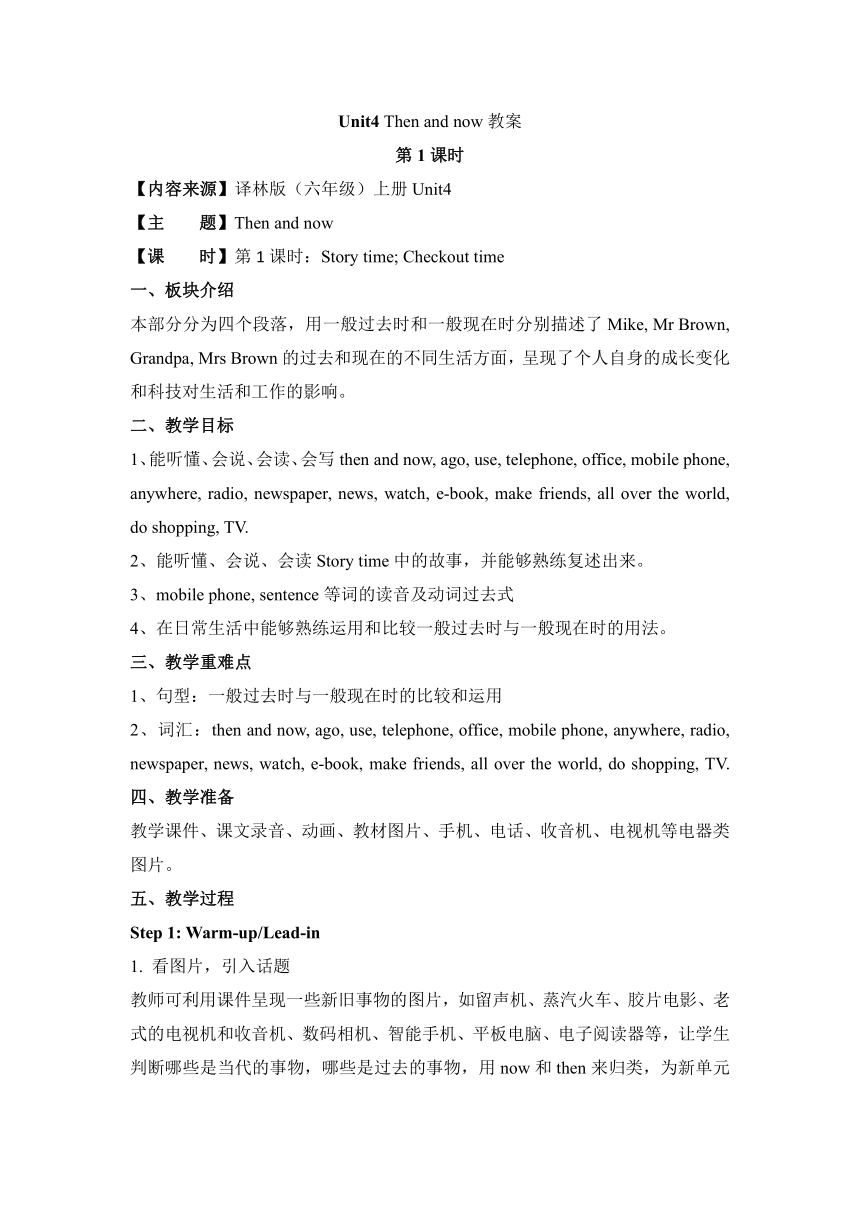 | |
| 格式 | doc | ||
| 文件大小 | 73.5KB | ||
| 资源类型 | 教案 | ||
| 版本资源 | 牛津译林版 | ||
| 科目 | 英语 | ||
| 更新时间 | 2021-06-23 14:01:20 | ||
图片预览

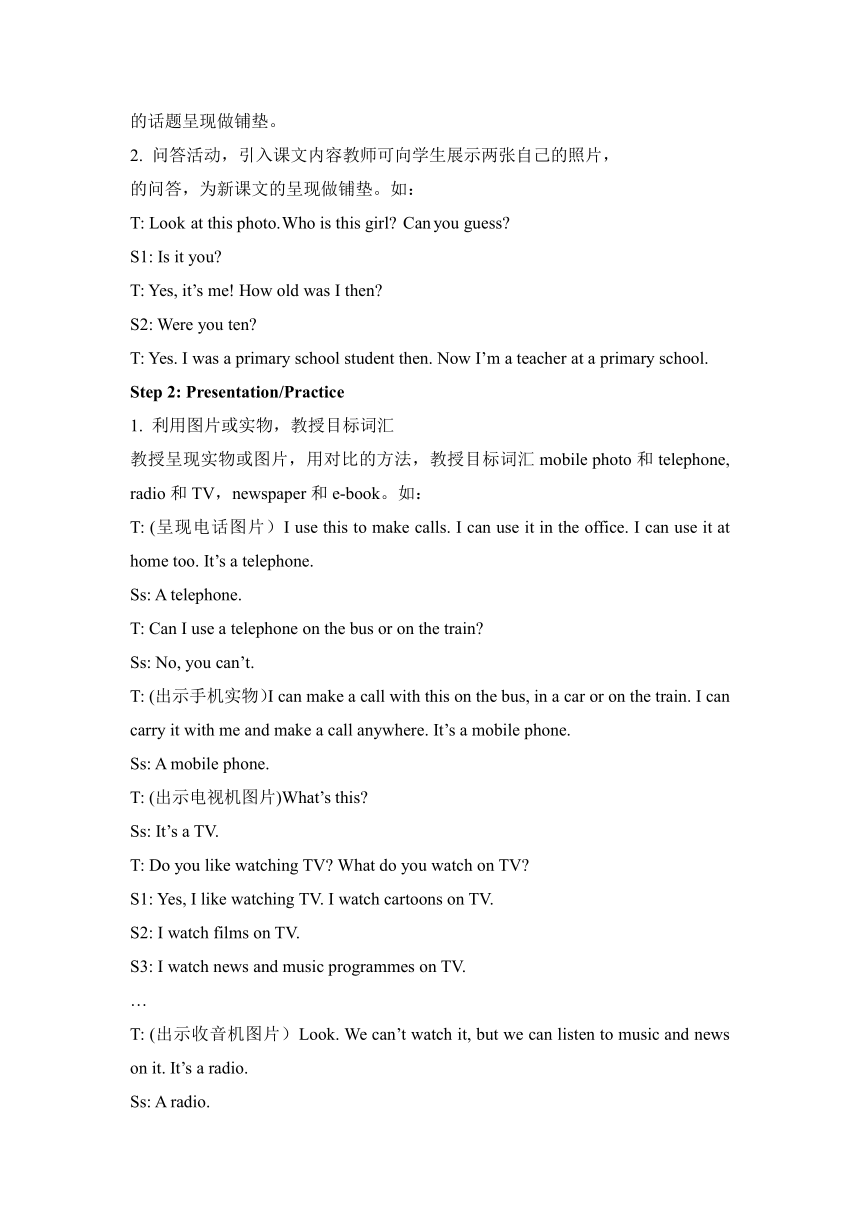
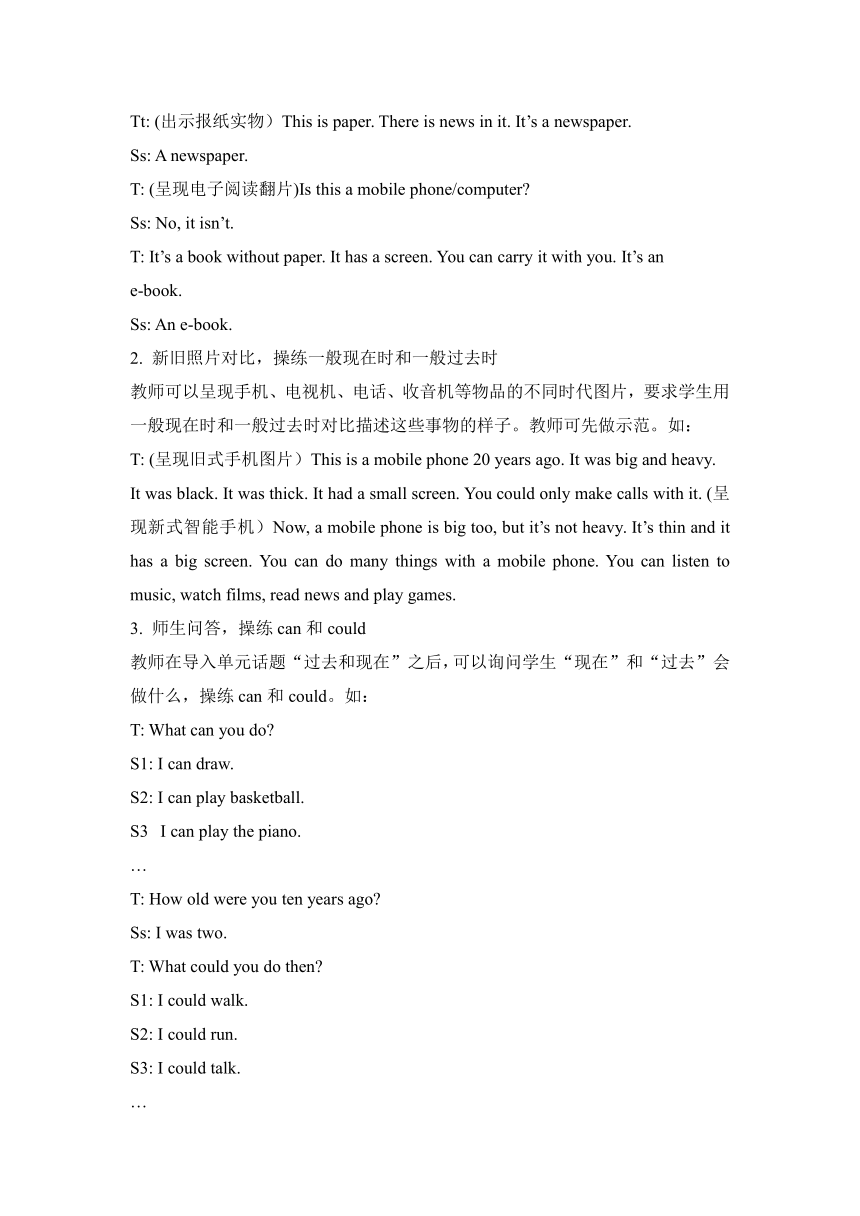
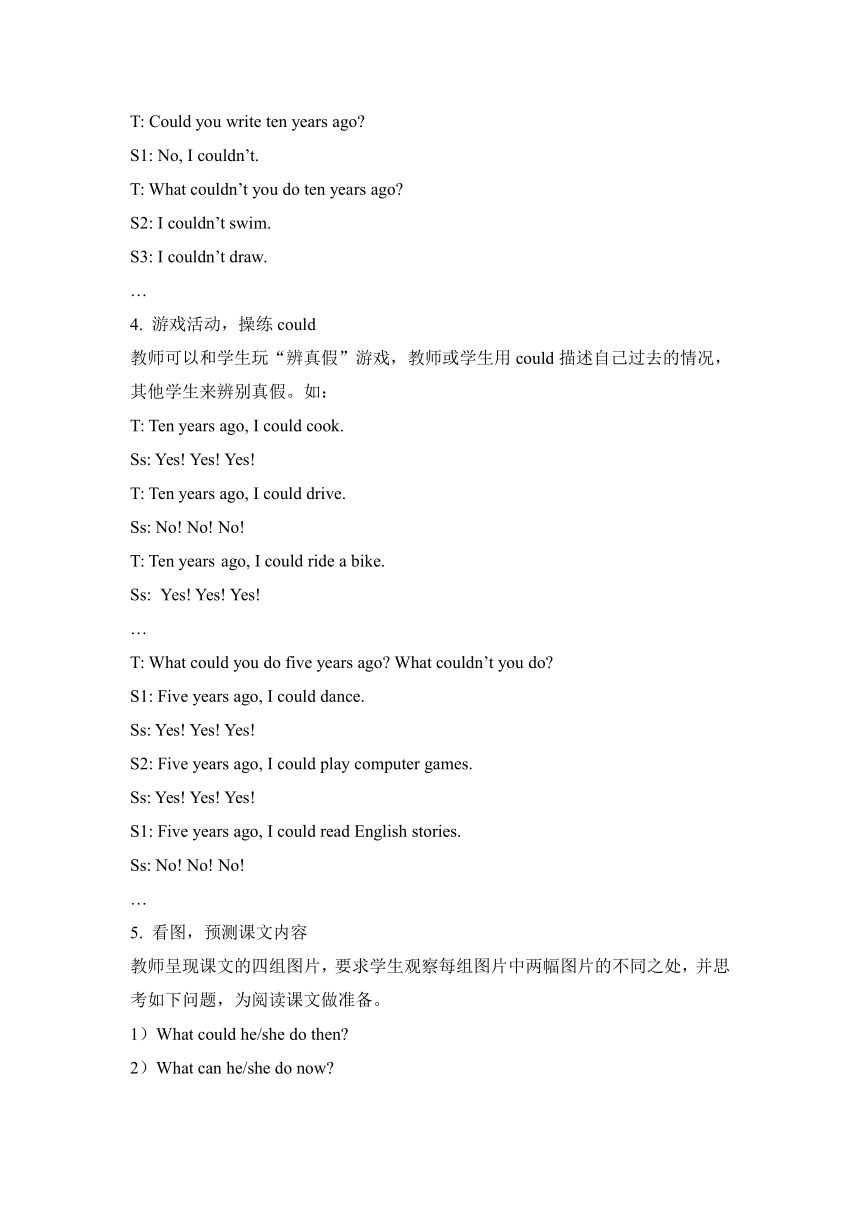
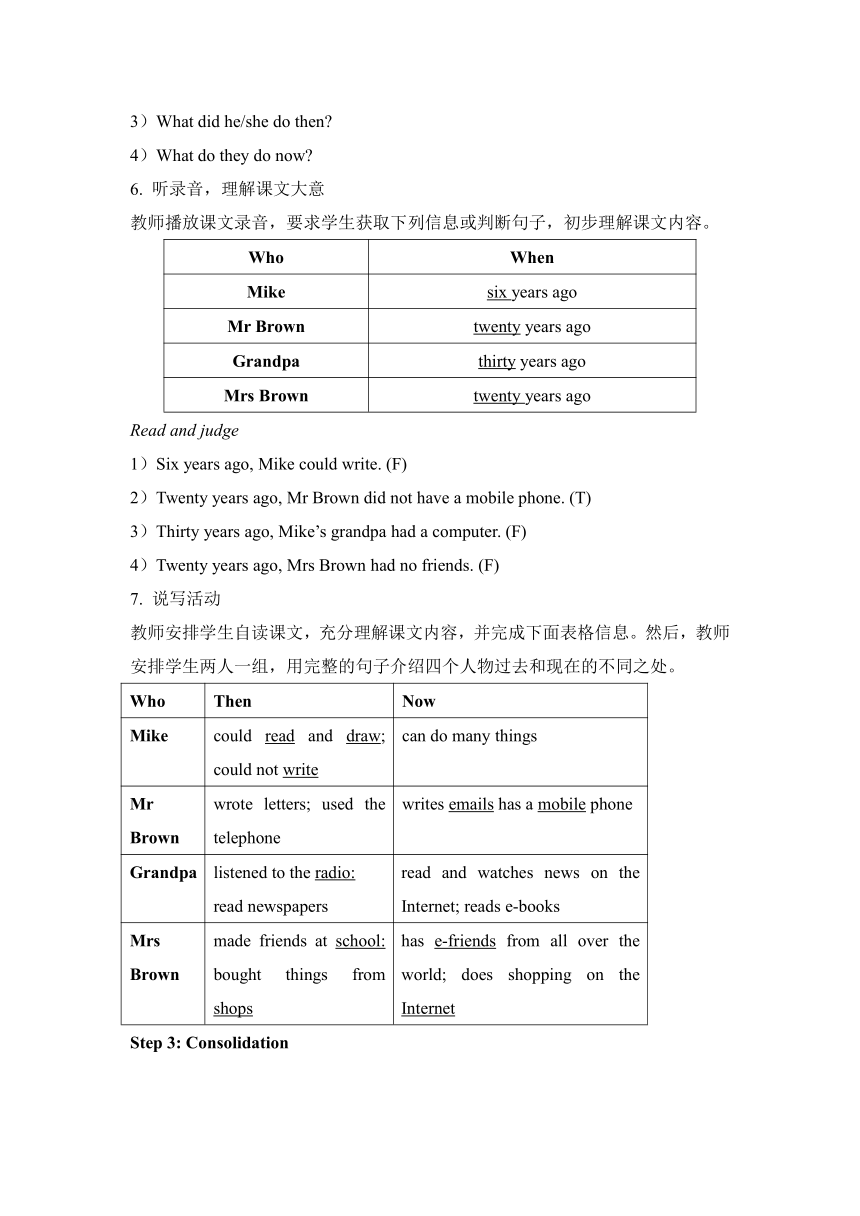
文档简介
Unit4 Then and now教案
第1课时
【内容来源】译林版(六年级)上册Unit4
【主 题】Then and now
【课 时】第1课时:Story time; Checkout time
一、板块介绍
本部分分为四个段落,用一般过去时和一般现在时分别描述了Mike, Mr Brown, Grandpa, Mrs Brown的过去和现在的不同生活方面,呈现了个人自身的成长变化和科技对生活和工作的影响。
二、教学目标
1、能听懂、会说、会读、会写then and now, ago, use, telephone, office, mobile phone, anywhere, radio, newspaper, news, watch, e-book, make friends, all over the world, do shopping, TV.
2、能听懂、会说、会读Story time中的故事,并能够熟练复述出来。
3、mobile phone, sentence等词的读音及动词过去式
4、在日常生活中能够熟练运用和比较一般过去时与一般现在时的用法。
三、教学重难点
1、句型:一般过去时与一般现在时的比较和运用
2、词汇:then and now, ago, use, telephone, office, mobile phone, anywhere, radio, newspaper, news, watch, e-book, make friends, all over the world, do shopping, TV.四、教学准备
教学课件、课文录音、动画、教材图片、手机、电话、收音机、电视机等电器类图片。
五、教学过程
Step 1: Warm-up/Lead-in
1. 看图片,引入话题
教师可利用课件呈现一些新旧事物的图片,如留声机、蒸汽火车、胶片电影、老式的电视机和收音机、数码相机、智能手机、平板电脑、电子阅读器等,让学生判断哪些是当代的事物,哪些是过去的事物,用now和then来归类,为新单元的话题呈现做铺垫。
2. 问答活动,引入课文内容教师可向学生展示两张自己的照片,
的问答,为新课文的呈现做铺垫。如:
T: Look at this photo. Who is this girl? Can you guess?
S1: Is it you?
T: Yes, it’s me! How old was I then?
S2: Were you ten?
T: Yes. I was a primary school student then. Now I’m a teacher at a primary school.
Step 2: Presentation/Practice
1. 利用图片或实物,教授目标词汇
教授呈现实物或图片,用对比的方法,教授目标词汇mobile photo和telephone, radio和TV,newspaper和e-book。如:
T: (呈现电话图片)I use this to make calls. I can use it in the office. I can use it at home too. It’s a telephone.
Ss: A telephone.
T: Can I use a telephone on the bus or on the train?
Ss: No, you can’t.
T: (出示手机实物)I can make a call with this on the bus, in a car or on the train. I can carry it with me and make a call anywhere. It’s a mobile phone.
Ss: A mobile phone.
T: (出示电视机图片)What’s this?
Ss: It’s a TV.
T: Do you like watching TV? What do you watch on TV?
S1: Yes, I like watching TV. I watch cartoons on TV.
S2: I watch films on TV.
S3: I watch news and music programmes on TV.
…
T: (出示收音机图片)Look. We can’t watch it, but we can listen to music and news on it. It’s a radio.
Ss: A radio.
Tt: (出示报纸实物)This is paper. There is news in it. It’s a newspaper.
Ss: A newspaper.
T: (呈现电子阅读翻片)Is this a mobile phone/computer?
Ss: No, it isn’t.
T: It’s a book without paper. It has a screen. You can carry it with you. It’s an
e-book.
Ss: An e-book.
2. 新旧照片对比,操练一般现在时和一般过去时
教师可以呈现手机、电视机、电话、收音机等物品的不同时代图片,要求学生用一般现在时和一般过去时对比描述这些事物的样子。教师可先做示范。如:
T: (呈现旧式手机图片)This is a mobile phone 20 years ago. It was big and heavy.
It was black. It was thick. It had a small screen. You could only make calls with it. (呈现新式智能手机)Now, a mobile phone is big too, but it’s not heavy. It’s thin and it has a big screen. You can do many things with a mobile phone. You can listen to music, watch films, read news and play games.
3. 师生问答,操练can和could
教师在导入单元话题“过去和现在”之后,可以询问学生“现在”和“过去”会做什么,操练can和could。如:
T: What can you do?
S1: I can draw.
S2: I can play basketball.
S3 I can play the piano.
…
T: How old were you ten years ago?
Ss: I was two.
T: What could you do then?
S1: I could walk.
S2: I could run.
S3: I could talk.
…
T: Could you write ten years ago?
S1: No, I couldn’t.
T: What couldn’t you do ten years ago?
S2: I couldn’t swim.
S3: I couldn’t draw.
…
4. 游戏活动,操练could
教师可以和学生玩“辨真假”游戏,教师或学生用could描述自己过去的情况,其他学生来辨别真假。如:
T: Ten years ago, I could cook.
Ss: Yes! Yes! Yes!
T: Ten years ago, I could drive.
Ss: No! No! No!
T: Ten years ago, I could ride a bike.
Ss: Yes! Yes! Yes!
…
T: What could you do five years ago? What couldn’t you do?
S1: Five years ago, I could dance.
Ss: Yes! Yes! Yes!
S2: Five years ago, I could play computer games.
Ss: Yes! Yes! Yes!
S1: Five years ago, I could read English stories.
Ss: No! No! No!
…
5. 看图,预测课文内容
教师呈现课文的四组图片,要求学生观察每组图片中两幅图片的不同之处,并思考如下问题,为阅读课文做准备。
1)What could he/she do then?
2)What can he/she do now?
3)What did he/she do then?
4)What do they do now?
6. 听录音,理解课文大意
教师播放课文录音,要求学生获取下列信息或判断句子,初步理解课文内容。
Who When
Mike six years ago
Mr Brown twenty years ago
Grandpa thirty years ago
Mrs Brown twenty years ago
Read and judge
1)Six years ago, Mike could write. (F)
2)Twenty years ago, Mr Brown did not have a mobile phone. (T)
3)Thirty years ago, Mike’s grandpa had a computer. (F)
4)Twenty years ago, Mrs Brown had no friends. (F)
7. 说写活动
教师安排学生自读课文,充分理解课文内容,并完成下面表格信息。然后,教师安排学生两人一组,用完整的句子介绍四个人物过去和现在的不同之处。
Who Then Now
Mike could read and draw; could not write can do many things
Mr Brown wrote letters; used the telephone writes emails has a mobile phone
Grandpa listened to the radio:
read newspapers read and watches news on the Internet; reads e-books
Mrs Brown made friends at school: bought things from shops has e-friends from all over the world; does shopping on the Internet
Step 3: Consolidation
1. 游戏活动,巩固目标词汇
1)Magic eyes
教师利用课件将本单元目标单词卡片做成快速闪现的效果,要求学生快速说出 物品的名称。
2)Listen and guess
教师用英语描述本单元目标词汇,要求学生猜出物品的名称。如:
T: We can use it to make calls anywhere. What is it?
Ss: It’s a mobile phone.
T: It’s a book without paper. What is it?
Ss: It’s an e-book.
T: We read it for news. What is it?
Ss: It’s a newspaper.
…
3)Jumping tiger
教师用红、蓝两种颜色出示Story time的若干动词,学生看到红色动词,说出它的 过去式;看到蓝色动词,说出它的第三人称单数;看到跳出的小老虎,则拍手。此游戏可帮助学生巩固动词的过去式和第三人称单数形式。
2. 卡片“翻翻乐”活动,操练can和could
教师准备两组卡片,一组是时间短语卡片,上面写着... years ago;另一组是动词短语卡片,可以是图片,也可以用文字呈现,如play the piano, play basketball, sing等。学生随机抽取两张卡片,然后根据自己的实际情况,用can和could造句。如:
S1: Ten years ago, I couldn’t play basketball. Now I can play.
S2: Three years ago, I could sing and dance.
S3: Five years ago, I couldn’t play the piano. Now I can’t play the piano either. ..I can
play the guitar.
…
3. 老照片的故事
教师要求学生展示自己带来老照片,可以是关于人的,也可以是关于物品和家庭生活的,并用一般过去时和一般现在时做简单介绍。教师可以板书重点句型,给学生一个口头表达的框架。如:
S: This is …years ago. He /She was … (age) then. …years ago, he/she was …He /She
could …Now he/she ...
4. 写作活动
教师安排学生完成学生用书P45 Checkout time中的Think and write活动。照片不局限于学生本人,也可以是家人和朋友的。
Step 4: Summary
单词:then and now, ago, use, telephone, office, mobile phone, anywhere, radio, newspaper, news, watch, e-book, make friends, all over the world, do shopping, TV.
运用和比较一般过去时与一般现在时的用法
Six years ago, Mike could read and draw ….
Twenty years ago, Mr Brown wrote ….
Thirty years ago, Mike’s grandpa listened to the radio and read
newspapers ….
Step 5: Homework
Pair work: 同学之间两人一组,分角色复述课文Story time.
Write and say
参考答案
Mike: write
Mr Brown: letters, telephone
Grandpa: on the Internet, e-books
Mrs Brown: at school, from shops, from all over the world
Unit4 第2课时
【内容来源】译林版(六年级)上册Unit4
【主 题】Then and now
【课 时】第2课时:Grammar time; Fun time
一、板块介绍
本板块呈现了带有时间副词短语 ... years ago的一般过去时陈述句,同时归纳再现了be动词和若干不规则动词的过去式。
二、教学目标
1、能够熟练掌握一般过去式。
2、熟知以下单词的过去式:am, can, do, get, go, eat, see, fly, take, read等动词的过去式。
三、教学重难点
能够时比较和运用一般过去式和一般现在式。
四、教学准备
教学课件
五、教学过程
Step 1: Warm-up/Lead-in
1. 游戏热身,复习旧知
Quick response
教师说出一个动词的原形或过去式,要求学生快速说出相应的过去式或原形。
Step 2: Presentation/Practice
Act and say
教师做动作,学生用动词过去式来描述这个动作。如:
T: (做听音乐动作)What did I do just now?
S: You listened to music.
…
2. 复述表格句子
教师安排学生阅读表格信息,然后要求个别学生或者全体学生逐一复述表格中呈 现的句子。
3. 小组活动,趣味造句
教师事先准备好二类词汇卡片,分别为when (表示过去的时间),who (人物)和what (事件)。其中,表示事件的卡片要用动词原形呈现。学生四人一个小组,其中三位学生分别从三组卡片中抽取一张并口述卡片内容,第四位学生要用一般过去式将三张卡片的信息组成一句完整的句子。教师可以安排学生在课上快速制作这些卡片。如:
S1: two days ago
S2: my father
S3: visit the Shanghai Museum
S4: Two days ago, my father visited the Shanghai Museum.
S2: last night
S3: my English teacher
S4: fly a kite
S1: Last night, my English teacher flew a kite.
…
4. 说写活动
教师安排学生完成学生用书P44 Checkout time中的Look and write。这里展现了 Mike—家的老照片,也可以看作是Story time的延伸。教师先安排学生独立完成, 然后邀请个别学生口述完整的句子,以核对答案。教师也可以鼓励学生展开想象, 并结合这些人物的其他信息,用could/could not对图片进行拓展描述。如:
Picture 1: Tim was one year old. He could not walk. He could not run. He could not
talk.
Picture 3: Mr Brown was 16 years old. He was a secondary school student. He could read and write. He could play football.
Step 3: Consolidation
Fun time
1. 复述表格句子
教师安排学生阅读表格信息,然后要求个别学生或者全体学生逐一复述表格中呈 现的句子。
2. 小组活动,趣味造句
教师事先准备好二类词汇卡片,分别为when (表示过去的时间),who (人物)和what (事件)。其中,表示事件的卡片要用动词原形呈现。学生四人一小组,其中三位学生分别从三组卡片中抽取一张并口述卡片内容,第四位学生要用一般过去式将三张卡片的信息组成一句完整的句子。教师可以安排学生在课上快速制作制作这些卡片。如:
S1: two days ago
S2: my father
S3: visit the Shanghai Museum
S4: Two days ago, my father visited the Shanghai Museum.
S2: last night
S3: my English teacher
S4: fly a kite
S1: Last night, my English teacher flew a kite.
…
3. 说写活动
教师安排学生完成学生用书P44 Checkout time中的Look and write。这里展现了 Mike—家的老照片,也可以看作是Story time的延伸。教师先安排学生独立完成, 然后邀请个别学生口述完整的句子,以核对答案。教师也可以鼓励学生展开想象, 并结合这些人物的其他信息,用could/could not对图片进行拓展描述。如:
Picture 1: Tim was one year old. He could not walk. He could not run. He could not
talk.
Picture 3: Mr Brown was 16 years old. He was a secondary school student. He could read and write. He could play football.
Step 4: Summary
说出下列单词的过去式:am/is/are; can; get; do; go; eat; see; fly; take; read.
比较和运用以下句子:(1)Six years ago, I couldn’t write.
(2)Twenty years ago, he wrote letters.
(3)Thirty years ago, they listened to the radio for news.
Step 5: Homework
自我介绍:结合自己不同年龄段的照片,用所学的英语简要介绍自己。
Unit4 第3课时
【内容来源】译林版(六年级)上册Unit4
【主 题】Then and now
【课 时】第3课时:Sound time; Culture time
一、板块介绍
Sound time: 本板块呈现了字母组合er在单词中的读音,即/?/。
Culture time: 本板块介绍了人类的两大重要发明:飞机和火车。教师可以呈现给学生更多的发明,以让他们体会科技对生活的影响。
The Americans invented the aeroplane.
美国人发明了飞机。
The British invented the train. 英国人发明了火车。
二、教学目标
1、能够熟练掌握字母组合er在单词中的读音,即/?/。
2、了解不同国家的飞机文化发明史,拓展学生知识面,提高学生学习英语的兴趣。
三、教学重难点
熟练掌握字母组合er在单词中的读音,即/?/。
四、教学准备
教学课件
五、教学过程
Step 1: Warm-up/Lead-in
小小自我介绍:结合上节课所布置的家庭作业,请学生上讲台向全班学生用英语做自我介绍。教师结合学生的自我介绍,并进行点评。
Step 2: Presentation/Practice
1. 示范朗读
教师示范朗读单词,也可以请发音较好的学生做示范。教师要提醒学生边听边体 会,找出它们含有的相同音素/?/。
2. 教师播放录音,要求学生跟读单词和绕口令。
3. 教师组织学生开展绕口令比赛,看谁读得既准确又有节奏。
4. 教师聚求学生找出已学过的含有/?/的单词,如father, brother, letter, answer, worker, writer, driver, farmer, together等。
5. 教师鼓励学生读出没有学过的含有/?/的单词,如singer, dancer, runner, swimmer, player 等。
6. 教师鼓励学生用含有字母组合er的单词创编新的句子。如:
1)My father and my brother often play together.
2)The writer wrote a letter to the singer last winter.
3)The player in the red sweater was the winner.
Step 3: Consolidation
Culture time
文化知识
飞机是人类在20世纪最重要的发明之一,有人将它与电视和电脑并列为20世纪对人类影响最大的三大发明。关于世界上最早的飞机到底是由谁发明的虽然还有争议,但是目前较为普遍的看法认为是美国的莱特兄弟发明了飞机。
The Americans invented the aeroplane.
美国人发明了飞机。
The British invented the train. 英国人发明了火车。
Step 4: Summary
My mother is a teacher.
She works hard every day.
My cousin is a worker.
Now he’s on holiday.
Step 5: Homework
上网查阅从古到近:汽车和火车不同的发展史,并用文字描述出来。
Unit4 第4课时
【内容来源】译林版(六年级)上册Unit4
【主 题】Then and now
【课 时】第4课时:Cartoon time
一、板块介绍
英语课上,Bobby总是开小差,被老师提醒多次。随后Bobby又与Sam讲话,Miss Fox生气了。Miss Fox请Sam用“鸡蛋”造一个句子。Sam因为没有认真听讲,给出的句子是“我昨天吃了一个蛋糕”。当老师问“鸡蛋”这个词在哪里时,Bobby灵机一动。说“鸡蛋在蛋糕里了”,引得同学们哈哈大笑。
二、教学目标
1、能够听说读写词汇及词组:go on, look out of, still, spell, make a sentence, with, yesterday.
2、熟练掌握句型:What day is today? …
三、教学重难点
能够看图片复述Cartoon time故事内容。
四、教学准备
教学课件
五、教学过程
Step 1: Warm-up/Lead-in
利用图片,导人故事
教师利用第一幅插图,引导学生讨论Who, What和Where,然后聚焦Bobby在这四幅图里的活动,要求学生用一般过去时描述。如:
Picture l: Bobby looked out of the window.
Picture 2: Bobby stood up and answered the teacher’s question.
Picture 3: Bobby talked with Sam.
Picture 4: Bobby stood up and all the other students laughed.
Step 2: Presentation/Practice
1. 听录音,理解故事大意。
教师播放录音,要求学生跟读模仿,并要求学生注意Bobby, Sam, 和Miss Fox的不同语气。教师可以设计一些阅读任务,以检查学生的理解情况。如:
Read and judge
1)It is a Chinese lesson. (F)
2)Today is Wednesday. (T)
3)Bobby listened carefully in class. (F)
4)Miss Fox was very angry. (T)
5)Sam made a sentence with “egg”. (F)
3. 带读故事,讲授难点
教师和学生一起朗读故事,并引导学生通过上下文语境理解词汇go on, spell,make a sentence等。
4. 分角色朗读
教师安排学生四人一组,朗读对话,并评出最佳朗读者。
Step 3: Consolidation
我是小小演说家:请学生准备10分钟左右,朗读课文Cartoon time. 在学生准备好之后,教师请学生积极踊跃参加并将Cartoon time课文复述出来。并注意学生的语音语调。教师并鼓励学生积极大胆参加集体活动,从而培养学生的集体荣誉感。教师并和班委一起评选出最佳演说家。
Step 4: Summary
复述课文Cartoon time.
Step 5: Homework
Role play: 分角色表演课文Cartoon time.
第1课时
【内容来源】译林版(六年级)上册Unit4
【主 题】Then and now
【课 时】第1课时:Story time; Checkout time
一、板块介绍
本部分分为四个段落,用一般过去时和一般现在时分别描述了Mike, Mr Brown, Grandpa, Mrs Brown的过去和现在的不同生活方面,呈现了个人自身的成长变化和科技对生活和工作的影响。
二、教学目标
1、能听懂、会说、会读、会写then and now, ago, use, telephone, office, mobile phone, anywhere, radio, newspaper, news, watch, e-book, make friends, all over the world, do shopping, TV.
2、能听懂、会说、会读Story time中的故事,并能够熟练复述出来。
3、mobile phone, sentence等词的读音及动词过去式
4、在日常生活中能够熟练运用和比较一般过去时与一般现在时的用法。
三、教学重难点
1、句型:一般过去时与一般现在时的比较和运用
2、词汇:then and now, ago, use, telephone, office, mobile phone, anywhere, radio, newspaper, news, watch, e-book, make friends, all over the world, do shopping, TV.四、教学准备
教学课件、课文录音、动画、教材图片、手机、电话、收音机、电视机等电器类图片。
五、教学过程
Step 1: Warm-up/Lead-in
1. 看图片,引入话题
教师可利用课件呈现一些新旧事物的图片,如留声机、蒸汽火车、胶片电影、老式的电视机和收音机、数码相机、智能手机、平板电脑、电子阅读器等,让学生判断哪些是当代的事物,哪些是过去的事物,用now和then来归类,为新单元的话题呈现做铺垫。
2. 问答活动,引入课文内容教师可向学生展示两张自己的照片,
的问答,为新课文的呈现做铺垫。如:
T: Look at this photo. Who is this girl? Can you guess?
S1: Is it you?
T: Yes, it’s me! How old was I then?
S2: Were you ten?
T: Yes. I was a primary school student then. Now I’m a teacher at a primary school.
Step 2: Presentation/Practice
1. 利用图片或实物,教授目标词汇
教授呈现实物或图片,用对比的方法,教授目标词汇mobile photo和telephone, radio和TV,newspaper和e-book。如:
T: (呈现电话图片)I use this to make calls. I can use it in the office. I can use it at home too. It’s a telephone.
Ss: A telephone.
T: Can I use a telephone on the bus or on the train?
Ss: No, you can’t.
T: (出示手机实物)I can make a call with this on the bus, in a car or on the train. I can carry it with me and make a call anywhere. It’s a mobile phone.
Ss: A mobile phone.
T: (出示电视机图片)What’s this?
Ss: It’s a TV.
T: Do you like watching TV? What do you watch on TV?
S1: Yes, I like watching TV. I watch cartoons on TV.
S2: I watch films on TV.
S3: I watch news and music programmes on TV.
…
T: (出示收音机图片)Look. We can’t watch it, but we can listen to music and news on it. It’s a radio.
Ss: A radio.
Tt: (出示报纸实物)This is paper. There is news in it. It’s a newspaper.
Ss: A newspaper.
T: (呈现电子阅读翻片)Is this a mobile phone/computer?
Ss: No, it isn’t.
T: It’s a book without paper. It has a screen. You can carry it with you. It’s an
e-book.
Ss: An e-book.
2. 新旧照片对比,操练一般现在时和一般过去时
教师可以呈现手机、电视机、电话、收音机等物品的不同时代图片,要求学生用一般现在时和一般过去时对比描述这些事物的样子。教师可先做示范。如:
T: (呈现旧式手机图片)This is a mobile phone 20 years ago. It was big and heavy.
It was black. It was thick. It had a small screen. You could only make calls with it. (呈现新式智能手机)Now, a mobile phone is big too, but it’s not heavy. It’s thin and it has a big screen. You can do many things with a mobile phone. You can listen to music, watch films, read news and play games.
3. 师生问答,操练can和could
教师在导入单元话题“过去和现在”之后,可以询问学生“现在”和“过去”会做什么,操练can和could。如:
T: What can you do?
S1: I can draw.
S2: I can play basketball.
S3 I can play the piano.
…
T: How old were you ten years ago?
Ss: I was two.
T: What could you do then?
S1: I could walk.
S2: I could run.
S3: I could talk.
…
T: Could you write ten years ago?
S1: No, I couldn’t.
T: What couldn’t you do ten years ago?
S2: I couldn’t swim.
S3: I couldn’t draw.
…
4. 游戏活动,操练could
教师可以和学生玩“辨真假”游戏,教师或学生用could描述自己过去的情况,其他学生来辨别真假。如:
T: Ten years ago, I could cook.
Ss: Yes! Yes! Yes!
T: Ten years ago, I could drive.
Ss: No! No! No!
T: Ten years ago, I could ride a bike.
Ss: Yes! Yes! Yes!
…
T: What could you do five years ago? What couldn’t you do?
S1: Five years ago, I could dance.
Ss: Yes! Yes! Yes!
S2: Five years ago, I could play computer games.
Ss: Yes! Yes! Yes!
S1: Five years ago, I could read English stories.
Ss: No! No! No!
…
5. 看图,预测课文内容
教师呈现课文的四组图片,要求学生观察每组图片中两幅图片的不同之处,并思考如下问题,为阅读课文做准备。
1)What could he/she do then?
2)What can he/she do now?
3)What did he/she do then?
4)What do they do now?
6. 听录音,理解课文大意
教师播放课文录音,要求学生获取下列信息或判断句子,初步理解课文内容。
Who When
Mike six years ago
Mr Brown twenty years ago
Grandpa thirty years ago
Mrs Brown twenty years ago
Read and judge
1)Six years ago, Mike could write. (F)
2)Twenty years ago, Mr Brown did not have a mobile phone. (T)
3)Thirty years ago, Mike’s grandpa had a computer. (F)
4)Twenty years ago, Mrs Brown had no friends. (F)
7. 说写活动
教师安排学生自读课文,充分理解课文内容,并完成下面表格信息。然后,教师安排学生两人一组,用完整的句子介绍四个人物过去和现在的不同之处。
Who Then Now
Mike could read and draw; could not write can do many things
Mr Brown wrote letters; used the telephone writes emails has a mobile phone
Grandpa listened to the radio:
read newspapers read and watches news on the Internet; reads e-books
Mrs Brown made friends at school: bought things from shops has e-friends from all over the world; does shopping on the Internet
Step 3: Consolidation
1. 游戏活动,巩固目标词汇
1)Magic eyes
教师利用课件将本单元目标单词卡片做成快速闪现的效果,要求学生快速说出 物品的名称。
2)Listen and guess
教师用英语描述本单元目标词汇,要求学生猜出物品的名称。如:
T: We can use it to make calls anywhere. What is it?
Ss: It’s a mobile phone.
T: It’s a book without paper. What is it?
Ss: It’s an e-book.
T: We read it for news. What is it?
Ss: It’s a newspaper.
…
3)Jumping tiger
教师用红、蓝两种颜色出示Story time的若干动词,学生看到红色动词,说出它的 过去式;看到蓝色动词,说出它的第三人称单数;看到跳出的小老虎,则拍手。此游戏可帮助学生巩固动词的过去式和第三人称单数形式。
2. 卡片“翻翻乐”活动,操练can和could
教师准备两组卡片,一组是时间短语卡片,上面写着... years ago;另一组是动词短语卡片,可以是图片,也可以用文字呈现,如play the piano, play basketball, sing等。学生随机抽取两张卡片,然后根据自己的实际情况,用can和could造句。如:
S1: Ten years ago, I couldn’t play basketball. Now I can play.
S2: Three years ago, I could sing and dance.
S3: Five years ago, I couldn’t play the piano. Now I can’t play the piano either. ..I can
play the guitar.
…
3. 老照片的故事
教师要求学生展示自己带来老照片,可以是关于人的,也可以是关于物品和家庭生活的,并用一般过去时和一般现在时做简单介绍。教师可以板书重点句型,给学生一个口头表达的框架。如:
S: This is …years ago. He /She was … (age) then. …years ago, he/she was …He /She
could …Now he/she ...
4. 写作活动
教师安排学生完成学生用书P45 Checkout time中的Think and write活动。照片不局限于学生本人,也可以是家人和朋友的。
Step 4: Summary
单词:then and now, ago, use, telephone, office, mobile phone, anywhere, radio, newspaper, news, watch, e-book, make friends, all over the world, do shopping, TV.
运用和比较一般过去时与一般现在时的用法
Six years ago, Mike could read and draw ….
Twenty years ago, Mr Brown wrote ….
Thirty years ago, Mike’s grandpa listened to the radio and read
newspapers ….
Step 5: Homework
Pair work: 同学之间两人一组,分角色复述课文Story time.
Write and say
参考答案
Mike: write
Mr Brown: letters, telephone
Grandpa: on the Internet, e-books
Mrs Brown: at school, from shops, from all over the world
Unit4 第2课时
【内容来源】译林版(六年级)上册Unit4
【主 题】Then and now
【课 时】第2课时:Grammar time; Fun time
一、板块介绍
本板块呈现了带有时间副词短语 ... years ago的一般过去时陈述句,同时归纳再现了be动词和若干不规则动词的过去式。
二、教学目标
1、能够熟练掌握一般过去式。
2、熟知以下单词的过去式:am, can, do, get, go, eat, see, fly, take, read等动词的过去式。
三、教学重难点
能够时比较和运用一般过去式和一般现在式。
四、教学准备
教学课件
五、教学过程
Step 1: Warm-up/Lead-in
1. 游戏热身,复习旧知
Quick response
教师说出一个动词的原形或过去式,要求学生快速说出相应的过去式或原形。
Step 2: Presentation/Practice
Act and say
教师做动作,学生用动词过去式来描述这个动作。如:
T: (做听音乐动作)What did I do just now?
S: You listened to music.
…
2. 复述表格句子
教师安排学生阅读表格信息,然后要求个别学生或者全体学生逐一复述表格中呈 现的句子。
3. 小组活动,趣味造句
教师事先准备好二类词汇卡片,分别为when (表示过去的时间),who (人物)和what (事件)。其中,表示事件的卡片要用动词原形呈现。学生四人一个小组,其中三位学生分别从三组卡片中抽取一张并口述卡片内容,第四位学生要用一般过去式将三张卡片的信息组成一句完整的句子。教师可以安排学生在课上快速制作这些卡片。如:
S1: two days ago
S2: my father
S3: visit the Shanghai Museum
S4: Two days ago, my father visited the Shanghai Museum.
S2: last night
S3: my English teacher
S4: fly a kite
S1: Last night, my English teacher flew a kite.
…
4. 说写活动
教师安排学生完成学生用书P44 Checkout time中的Look and write。这里展现了 Mike—家的老照片,也可以看作是Story time的延伸。教师先安排学生独立完成, 然后邀请个别学生口述完整的句子,以核对答案。教师也可以鼓励学生展开想象, 并结合这些人物的其他信息,用could/could not对图片进行拓展描述。如:
Picture 1: Tim was one year old. He could not walk. He could not run. He could not
talk.
Picture 3: Mr Brown was 16 years old. He was a secondary school student. He could read and write. He could play football.
Step 3: Consolidation
Fun time
1. 复述表格句子
教师安排学生阅读表格信息,然后要求个别学生或者全体学生逐一复述表格中呈 现的句子。
2. 小组活动,趣味造句
教师事先准备好二类词汇卡片,分别为when (表示过去的时间),who (人物)和what (事件)。其中,表示事件的卡片要用动词原形呈现。学生四人一小组,其中三位学生分别从三组卡片中抽取一张并口述卡片内容,第四位学生要用一般过去式将三张卡片的信息组成一句完整的句子。教师可以安排学生在课上快速制作制作这些卡片。如:
S1: two days ago
S2: my father
S3: visit the Shanghai Museum
S4: Two days ago, my father visited the Shanghai Museum.
S2: last night
S3: my English teacher
S4: fly a kite
S1: Last night, my English teacher flew a kite.
…
3. 说写活动
教师安排学生完成学生用书P44 Checkout time中的Look and write。这里展现了 Mike—家的老照片,也可以看作是Story time的延伸。教师先安排学生独立完成, 然后邀请个别学生口述完整的句子,以核对答案。教师也可以鼓励学生展开想象, 并结合这些人物的其他信息,用could/could not对图片进行拓展描述。如:
Picture 1: Tim was one year old. He could not walk. He could not run. He could not
talk.
Picture 3: Mr Brown was 16 years old. He was a secondary school student. He could read and write. He could play football.
Step 4: Summary
说出下列单词的过去式:am/is/are; can; get; do; go; eat; see; fly; take; read.
比较和运用以下句子:(1)Six years ago, I couldn’t write.
(2)Twenty years ago, he wrote letters.
(3)Thirty years ago, they listened to the radio for news.
Step 5: Homework
自我介绍:结合自己不同年龄段的照片,用所学的英语简要介绍自己。
Unit4 第3课时
【内容来源】译林版(六年级)上册Unit4
【主 题】Then and now
【课 时】第3课时:Sound time; Culture time
一、板块介绍
Sound time: 本板块呈现了字母组合er在单词中的读音,即/?/。
Culture time: 本板块介绍了人类的两大重要发明:飞机和火车。教师可以呈现给学生更多的发明,以让他们体会科技对生活的影响。
The Americans invented the aeroplane.
美国人发明了飞机。
The British invented the train. 英国人发明了火车。
二、教学目标
1、能够熟练掌握字母组合er在单词中的读音,即/?/。
2、了解不同国家的飞机文化发明史,拓展学生知识面,提高学生学习英语的兴趣。
三、教学重难点
熟练掌握字母组合er在单词中的读音,即/?/。
四、教学准备
教学课件
五、教学过程
Step 1: Warm-up/Lead-in
小小自我介绍:结合上节课所布置的家庭作业,请学生上讲台向全班学生用英语做自我介绍。教师结合学生的自我介绍,并进行点评。
Step 2: Presentation/Practice
1. 示范朗读
教师示范朗读单词,也可以请发音较好的学生做示范。教师要提醒学生边听边体 会,找出它们含有的相同音素/?/。
2. 教师播放录音,要求学生跟读单词和绕口令。
3. 教师组织学生开展绕口令比赛,看谁读得既准确又有节奏。
4. 教师聚求学生找出已学过的含有/?/的单词,如father, brother, letter, answer, worker, writer, driver, farmer, together等。
5. 教师鼓励学生读出没有学过的含有/?/的单词,如singer, dancer, runner, swimmer, player 等。
6. 教师鼓励学生用含有字母组合er的单词创编新的句子。如:
1)My father and my brother often play together.
2)The writer wrote a letter to the singer last winter.
3)The player in the red sweater was the winner.
Step 3: Consolidation
Culture time
文化知识
飞机是人类在20世纪最重要的发明之一,有人将它与电视和电脑并列为20世纪对人类影响最大的三大发明。关于世界上最早的飞机到底是由谁发明的虽然还有争议,但是目前较为普遍的看法认为是美国的莱特兄弟发明了飞机。
The Americans invented the aeroplane.
美国人发明了飞机。
The British invented the train. 英国人发明了火车。
Step 4: Summary
My mother is a teacher.
She works hard every day.
My cousin is a worker.
Now he’s on holiday.
Step 5: Homework
上网查阅从古到近:汽车和火车不同的发展史,并用文字描述出来。
Unit4 第4课时
【内容来源】译林版(六年级)上册Unit4
【主 题】Then and now
【课 时】第4课时:Cartoon time
一、板块介绍
英语课上,Bobby总是开小差,被老师提醒多次。随后Bobby又与Sam讲话,Miss Fox生气了。Miss Fox请Sam用“鸡蛋”造一个句子。Sam因为没有认真听讲,给出的句子是“我昨天吃了一个蛋糕”。当老师问“鸡蛋”这个词在哪里时,Bobby灵机一动。说“鸡蛋在蛋糕里了”,引得同学们哈哈大笑。
二、教学目标
1、能够听说读写词汇及词组:go on, look out of, still, spell, make a sentence, with, yesterday.
2、熟练掌握句型:What day is today? …
三、教学重难点
能够看图片复述Cartoon time故事内容。
四、教学准备
教学课件
五、教学过程
Step 1: Warm-up/Lead-in
利用图片,导人故事
教师利用第一幅插图,引导学生讨论Who, What和Where,然后聚焦Bobby在这四幅图里的活动,要求学生用一般过去时描述。如:
Picture l: Bobby looked out of the window.
Picture 2: Bobby stood up and answered the teacher’s question.
Picture 3: Bobby talked with Sam.
Picture 4: Bobby stood up and all the other students laughed.
Step 2: Presentation/Practice
1. 听录音,理解故事大意。
教师播放录音,要求学生跟读模仿,并要求学生注意Bobby, Sam, 和Miss Fox的不同语气。教师可以设计一些阅读任务,以检查学生的理解情况。如:
Read and judge
1)It is a Chinese lesson. (F)
2)Today is Wednesday. (T)
3)Bobby listened carefully in class. (F)
4)Miss Fox was very angry. (T)
5)Sam made a sentence with “egg”. (F)
3. 带读故事,讲授难点
教师和学生一起朗读故事,并引导学生通过上下文语境理解词汇go on, spell,make a sentence等。
4. 分角色朗读
教师安排学生四人一组,朗读对话,并评出最佳朗读者。
Step 3: Consolidation
我是小小演说家:请学生准备10分钟左右,朗读课文Cartoon time. 在学生准备好之后,教师请学生积极踊跃参加并将Cartoon time课文复述出来。并注意学生的语音语调。教师并鼓励学生积极大胆参加集体活动,从而培养学生的集体荣誉感。教师并和班委一起评选出最佳演说家。
Step 4: Summary
复述课文Cartoon time.
Step 5: Homework
Role play: 分角色表演课文Cartoon time.
